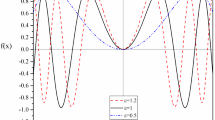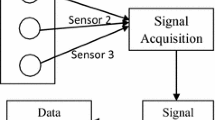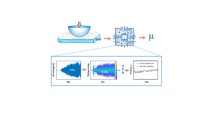Abstract
Chatter is a kind of self-excited vibration, which will result in very poor quality and dimensional accuracy on the machined surface, even a harmful effect on machining operation. A simple, reliable, and accurate chatter identification algorithm is crucial for taking control strategy before it is fully developed. This paper proposes a novel frequency-domain search (FDS) algorithm to identify the chatter during milling. An identification feature based on vibration base frequency is extracted according to the FDS algorithm, where the complicated signal processing algorithms are not needed before feature extraction. Compared with most of the existing identification features, the introduced feature does not need to set thresholds according to different machining conditions. Meanwhile, the feature extraction only needs a small amount of data to guarantee the timeliness of identification. Hammer test and milling experiments with various cutting parameters are carried out, and both force signal and vibration signal in the experiments are utilized to validate the effectiveness of the proposed algorithm. The results show that the proposed algorithm can identify the milling chatter accurately, whether using force signal or vibration signal, even slight chatter in the initial machining stage can be identified. Furthermore, the research reveals that dominant chatter frequencies appear around the natural frequency of the spindle-tool system but do not exactly equal to its natural frequency. The chatter frequencies are found to be determined by the combination of natural characteristics of the system and cutting conditions.
















Similar content being viewed by others
Abbreviations
- a e :
-
Radial depth of cut (mm)
- a p :
-
Axial depth of cut (mm)
- f C :
-
Vibration base frequency (Hz)
- f cfr :
-
Searching range of the proposed algorithm
- \( {f}_{\mathrm{cfr}}^a \) :
-
Left interval of the searching range (Hz)
- \( {f}_{\mathrm{cfr}}^b \) :
-
Right interval of the searching range (Hz)
- f d :
-
Difference between fIMF and fTPF (Hz)
- f IMF :
-
Identified maximum frequency (Hz)
- f MCF :
-
Multiple chatter frequencies (Hz)
- f SRF :
-
Spindle rotation frequency (Hz)
- f STF :
-
Surface topography frequency (Hz)
- f TPF :
-
Tooth pass frequency (Hz)
- f z :
-
Feed per tooth (Hz)
- Fx, Fy :
-
Cutting force signal in x and y directions, respectively (N)
- k b :
-
Multiple of initial search frequency
- L w :
-
Measured length of surface profile (mm)
- n :
-
Spindle speed (rpm)
- n w :
-
Number of the corrugations in the scope of Lw
- N t :
-
Number of teeth
- Sx, Sy :
-
Spectrum of cutting force signal of x and y directions, respectively
References
Yang K, Wang GF, Dong Y, Zhang QB, Sang LL (2019) Early chatter identification based on an optimized variational mode decomposition. Mech Syst Signal Pr 115:238–254. https://doi.org/10.1016/j.ymssp.2018.05.052
Aslan D, Altintas Y (2018) On-line chatter detection in milling using drive motor current commands extracted from CNC. Int J Mach Tool Manu 132:64–80. https://doi.org/10.1016/j.ijmachtools.2018.04.007
Catania G, Mancinelli N (2011) Theoretical-experimental modeling of milling machines for the prediction of chatter vibration. Int J Mach Tool Manu 51:339–348. https://doi.org/10.1016/j.ijmachtools.2018.04.007
Kayhan M, Budak E (2009) An experimental investigation of chatter effects on tool life. P I Mech Eng B-J Eng 223(11):1455–1463. https://doi.org/10.1243/09544054JEM1506
Li ZQ, Wang ZK, Shi XF (2017) Fast prediction of chatter stability lobe diagram for milling process using frequency response function or modal parameters. Int J Adv Manuf Technol 89:2603–2612. https://doi.org/10.1007/s00170-016-9959-4
Grossi N, Montevecchi F, Sallese L, Scippa A, Campatelli G (2017) Chatter stability prediction for high-speed milling through a novel experimental-analytical approach. Int J Adv Manuf Technol 89:2587–2601. https://doi.org/10.1007/s00170-016-9832-5
Graham E, Mehrpouya M, Park SS (2013) Robust prediction of chatter stability in milling based on the analytical chatter stability. J Manuf Process 15:508–517. https://doi.org/10.1016/j.jmapro.2013.08.005
Altintas Y, Budak E (1995) Analytical prediction of stability lobes in milling. CIRP Ann-Manuf Techn 44:357–362. https://doi.org/10.1016/S0007-8506(07)62342-7
Najafi B, Hakim H (1992) A comparative study of non-parametric spectral estimators for application in machining vibration analysis. Mech Syst Signal Pr 6:551–574. https://doi.org/10.1016/0888-3270(92)90049-O
Lamraoui M, Thomas M, El Badaoui M, Girardin F (2014) Indicators for monitoring chatter in milling based on instantaneous angular speeds. Mech Syst Signal Pr 44:72–85. https://doi.org/10.1016/j.ymssp.2013.05.002
Suh CS, Khurjekar PP, Yang B (2002) Characterisation and identification of dynamic instability in milling operation. Mech Syst Signal Pr 16(5):853–872. https://doi.org/10.1006/mssp.2002.1497
Feng JL, Sun ZL, Jiang ZH, Yang L (2016) Identification of chatter in milling of Ti-6Al-4V titanium alloy thin-walled workpieces based on cutting force signals and surface topography. Int J Adv Manuf Technol 82:1909–1920. https://doi.org/10.1007/s00170-015-7509-0
Kuljanic E, Sortino M, Totis G (2008) Multisensor approaches for chatter detection in milling. J Sound Vib 312:672–693. https://doi.org/10.1016/j.jsv.2007.11.006
Niu JC, Ning GC, Shen YJ, Yang SP (2019) Detection and identification of cutting chatter based on improved variational nonlinear chirp mode decomposition. Int J Adv Manuf Technol 104:2567–2578. https://doi.org/10.1007/s00170-019-04035-z
Gao J, Song QH, Liu ZQ (2018) Chatter detection and stability region acquisition in thin-walled workpiece milling based on CMWT. Int J Adv Manuf Technol 98:699–713. https://doi.org/10.1007/s00170-018-2306-1
Ye J, Feng PF, Xu C, Ma Y, Huang SG (2018) A novel approach for chatter online monitoring using coefficient of variation in machining process. Int J Adv Manuf Technol 96:287–297. https://doi.org/10.1007/s00170-017-1544-y
Ji YJ, Wang XB, Liu ZB, Yan ZH, Jiao L, Wang DQ, Wang JQ (2017) EEMD-based online milling chatter detection by fractal dimension and power spectral entropy. Int J Adv Manuf Technol 92:1185–1200. https://doi.org/10.1007/s00170-017-0183-7
Fu Y, Zhang Y, Zhou H, Li DQ, Liu HQ, Qiao HY, Wang XQ (2016) Timely online chatter detection in end milling process. Mech Syst Signal Pr 75:668–688. https://doi.org/10.1016/j.ymssp.2016.01.003
Cao HR, Zhou K, Chen XF, Zhang XW (2017) Early chatter detection in end milling based on multi-feature fusion and 3σ criterion. Int J Adv Manuf Technol 92:4387–4397. https://doi.org/10.1007/s00170-017-0476-x
Li K, He SP, Luo B, Li B, Liu HQ, Mao XY (2019) Online chatter detection in milling process based on VMD and multiscale entropy. Int J Adv Manuf Technol 105:5009–5022. https://doi.org/10.1007/s00170-019-04478-4
Chen GS, Zheng QZ (2018) Online chatter detection of the end milling based on wavelet packet transform and support vector machine recursive feature elimination. Int J Adv Manuf Technol 95:775–784. https://doi.org/10.1007/s00170-017-1242-9
Cao HR, Lei YG, He ZJ (2013) Chatter identification in end milling process using wavelet packets and Hilbert-Huang transform. Int J Mach Tool Manu 69:11–19. https://doi.org/10.1016/j.ijmachtools.2013.02.007
Choi T, Shin YC (2003) Online chatter detection using wavelet-based parameter estimation. J Manuf Sci E-T ASME 125(1):21–28. https://doi.org/10.1115/1.1531113
Al-Regib E, Ni J (2010) Chatter detection in machining using nonlinear energy operator. J Dyn Syst-T ASME 132:034502(1-4). https://doi.org/10.1115/1.4001331
Caliskan H, Kilic ZM, Altintas Y (2018) Online energy-based milling chatter detection. J Manuf Sci E-T ASME 140:111012 (1-12). https://doi.org/10.1115/1.4040617
Liu HB, Bo QL, Zhang H, Wang YQ (2018) Analysis of Q-factor’s identification ability for thin-walled part flank and mirror milling chatter. Int J Adv Manuf Technol 99:1673–1686. https://doi.org/10.1007/s00170-018-2580-y
Wang GF, Dong HY, Guo YJ, Ke YL (2018) Early chatter identification of robotic boring process using measured force of dynamometer. Int J Adv Manuf Technol 94:1243–1252. https://doi.org/10.1007/s00170-017-0941-6
Zhang Z, Li HG, Meng G, Tu XT, Cheng CM (2016) Chatter detection in milling process based on the energy entropy of VMD and WPD. Int J Mach Tool Manu 108:106–112. https://doi.org/10.1016/j.ijmachtools.2016.06.002
Berger B, Belai C, Anand D (2003) Chatter identification with mutual information. J Sound Vib 267(1):178–186. https://doi.org/10.1016/S0022-460X(03)00067
Schmitz TL (2003) Chatter recognition by a statistical evaluation of the synchronously sampled audio signal. J Sound Vib 262(3):721–730. https://doi.org/10.1016/S0022-460X(03)00119-6
Rusinek R, Lajmert P, Kecik K, Kruszynski B, Warminski J (2015) Chatter identification methods on the basis of time series measured during titanium superalloy milling. Int J Mech Sci 99:196–207. https://doi.org/10.1016/j.ijmecsci.2015.05.013
Shao YM, Deng X, Yuan YL, Mechefske CK, Chen ZG (2014) Characteristic recognition of chatter mark vibration in a rolling mill based on the non-dimensional parameters of the vibration signal. J Mech Sci Technol 28(6):2075–2080. https://doi.org/10.1007/s12206-014-0106-6
Ma L, Melkote SN, Castle JB (2013) A model based computationally efficient method for on-line detection of chatter in milling. J Manuf Sci E-T ASME 135(3):1–11. https://doi.org/10.1115/MSEC2013-1031
van Dijk NJM, Doppenberg EJJ, Faassen RPH, van de Wouw N, Oosterling JAJ, Nijmeijer H (2010) Automatic in-process chatter avoidance in the high-speed milling process. J Dyn Syst-T ASME 132(3):333–342. https://doi.org/10.1115/1.4000821
Wan SK, Li XH, Chen W, Hong J (2018) Investigation on milling chatter identification at early stage with variance ratio and Hilbert-Huang transform. Int J Adv Manuf Technol 95:3563–3573. https://doi.org/10.1007/s00170-017-1410-y
Insperger T, Stépán G, Bayly PV, Mann BP (2003) Multiple chatter frequencies in milling processes. J Sound Vib 262:333–345. https://doi.org/10.1016/S0022-460X(02)01131-8
Dombovari Z, Iglesias A, Zatarain M, Insperger T (2011) Prediction of multiple dominant chatter frequencies in milling process. Int J Mach Tool Manu 51:457–464. https://doi.org/10.1016/j.ijmachtools.2011.02.002
Wang GF, Peng DB, Qin XD, Cui YH (2012) An improved dynamic milling force coefficients identification method considering edge force. J Mech Sci Technol 26(5):1585–1590. https://doi.org/10.1007/s12206-012-0306-x
Ding Y, Zhu LM, Zhang XJ, Ding H (2010) A full-discretization method for prediction of milling stability. Int J Mach Tool Manu 50:502–509. https://doi.org/10.1016/j.ijmachtools.2010.01.003
Acknowledgments
This project is supported by the Natural Science Foundation of Tianjin (No. 18JCQNJC75600), National Natural Science Foundation of China (No. 51705362), and Science & Technology Development Fund of Tianjin Education Commission for Higher Education (No. 2017KJ081).
Author information
Authors and Affiliations
Corresponding author
Additional information
Publisher’s note
Springer Nature remains neutral with regard to jurisdictional claims in published maps and institutional affiliations.
Rights and permissions
About this article
Cite this article
Chang, L., Weiwei, X. & Lei, G. Identification of milling chatter based on a novel frequency-domain search algorithm. Int J Adv Manuf Technol 109, 2393–2407 (2020). https://doi.org/10.1007/s00170-020-05789-7
Received:
Accepted:
Published:
Issue Date:
DOI: https://doi.org/10.1007/s00170-020-05789-7




